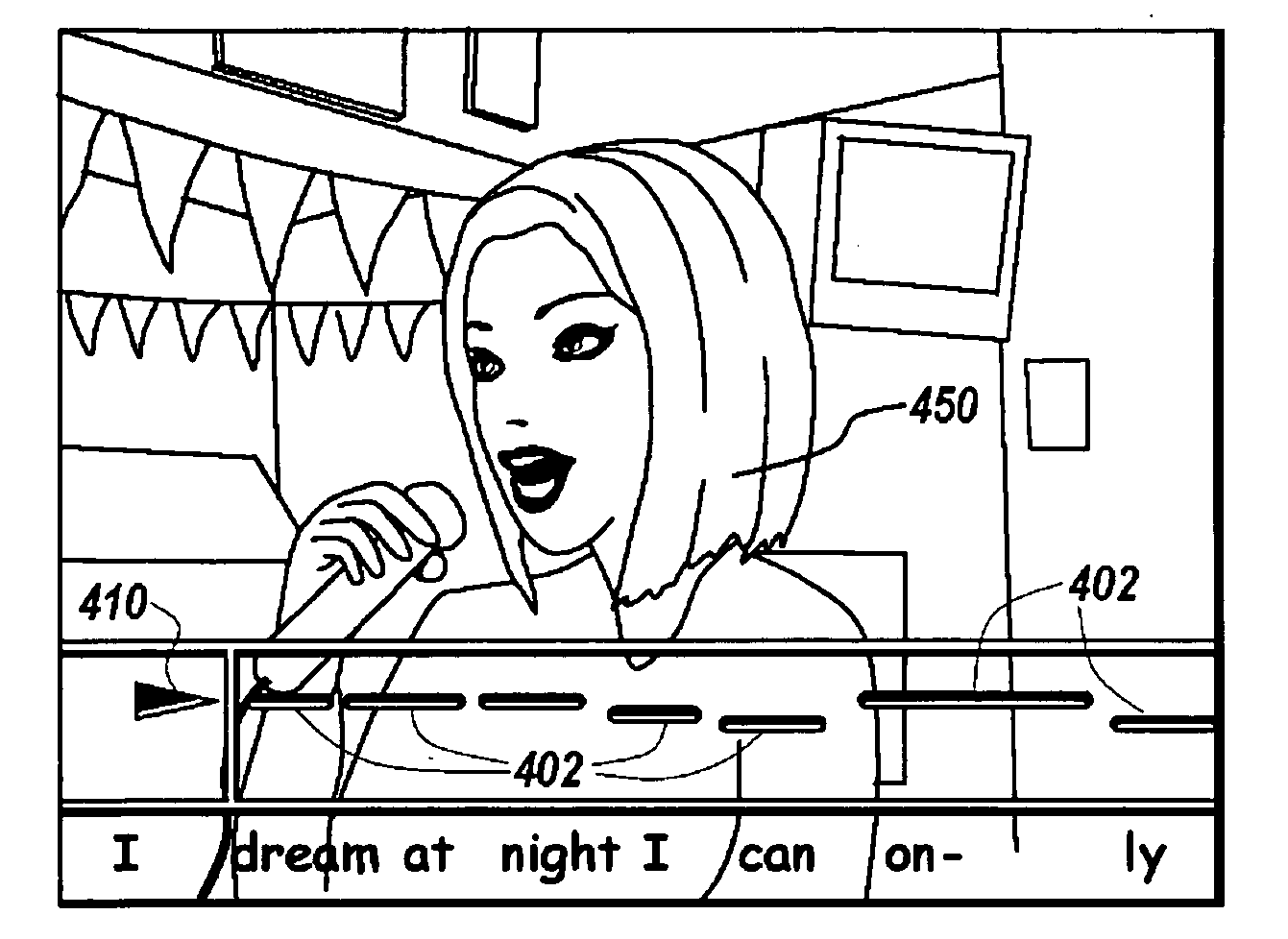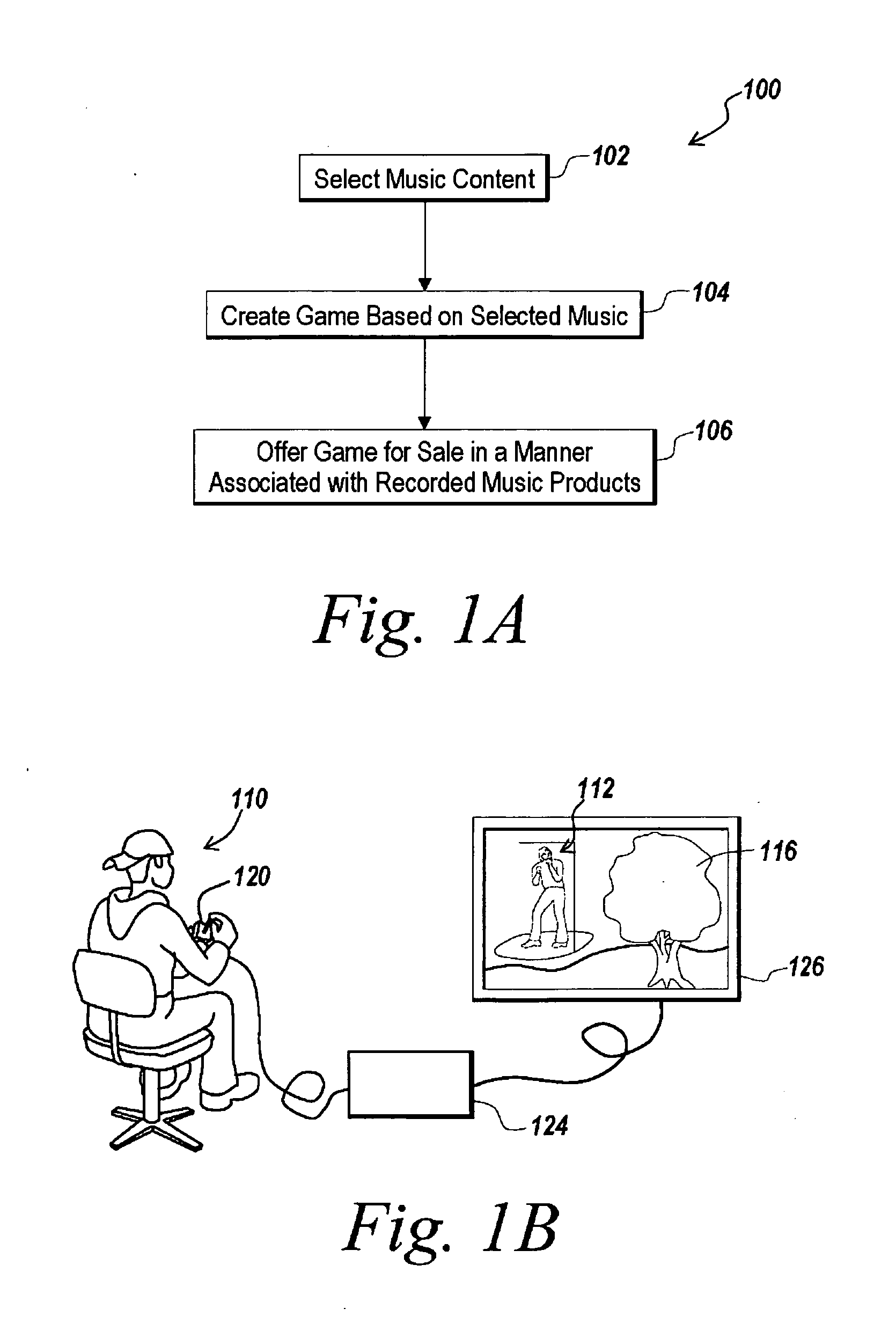Creating and selling a music-based video game
a music-based video game and music technology, applied in the field of entertainment products, can solve the problems that the music-based video game that is enjoyed by one consumer might not be enjoyed by and the video game that is enjoyed by another consumer might not be popular with a majority of other consumers
- Summary
- Abstract
- Description
- Claims
- Application Information
AI Technical Summary
Benefits of technology
Problems solved by technology
Method used
Image
Examples
example 1
[0029] Referring now to FIG. 2, the video game may be based on all, or a portion of, licensed music content created by a popular band enjoyed by specific consumers. As can be seen from FIG. 2, each of the members of the band 202, 204, 206 has been modeled and animated in the game environment. The game includes a “lane”210 that appears to be three-dimensional, that is, it appears to lie in a plane between the player of the game and one of the animated band members. The player is able to choose a particular animated member of the band to interact with using a game controller. The image of the band member may be computer-generated or, alternatively, a digital image, such as a video capture, of the band member may be used.
[0030] It is, of course, understood that the display of three-dimensional “virtual” space is an illusion achieved by mathematically “rendering” two-dimensional images from objects in a three-dimensional “virtual space” using a “virtual camera,” just as a physical came...
example 2
[0036] Referring now to FIG. 3, another embodiment of a rhythm-action video game is shown in which a lane that appears to be three-dimensional represents a particular instrument or voice present in a song. As will be familiar to those having experience with two games sold by Sony Computer Entertainment America, FreQuency and Amplitude, the player controls a “beat blaster”310 to travel along lanes 320 and shoot in synchrony with the music game elements 330 displayed on the lane 320. Successfully shooting game elements 330 causes the music associated with the game element 330 to be played. Except for the absence of the digitized images of band members responding to game activity, gameplay mechanics are the same as those described above in Example 1. Other examples of rhythm-action games include Parappa the Rapper, Beat Planet Music, Stolen Song, and EyeToy: Groove, all of which are sold by Sony Computer Entertainment; BeatMania, DrumMania, KeyboardMania, and Guitar Freaks, all of whic...
example 3
[0037] Referring now to FIG. 4, an embodiment of a “sing-along” video game is shown. The notes of a vocal track are represented by “note tubes”402 that appear along the bottom of the gameplay screen and flow horizontally as the music plays. The vertical position of the note tube represents the pitch to be sung by the player; the length of the note tube indicates for how long the player must hold that pitch. The triangle 410 provides the player with visual feedback regarding the pitch of the note that is currently being sung.
[0038] In this example, a player is allowed to “sing-along” with content from licensed songs that have been used to form the basis for the video game. In some embodiments, the game allows a player to “sing-along” with the musical artist responsible for the licensed songs. In these embodiments, the player's character 450 may have the appearance of the musical artist with whom the song in most strongly associated.
[0039] In embodiments in which the gaming platform...
PUM
 Login to View More
Login to View More Abstract
Description
Claims
Application Information
 Login to View More
Login to View More - R&D
- Intellectual Property
- Life Sciences
- Materials
- Tech Scout
- Unparalleled Data Quality
- Higher Quality Content
- 60% Fewer Hallucinations
Browse by: Latest US Patents, China's latest patents, Technical Efficacy Thesaurus, Application Domain, Technology Topic, Popular Technical Reports.
© 2025 PatSnap. All rights reserved.Legal|Privacy policy|Modern Slavery Act Transparency Statement|Sitemap|About US| Contact US: help@patsnap.com



